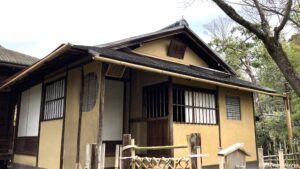The standing original castle in Japan, the history of Inuyama Castle Lord, Narusa Masanari
Inuyama Castle, a National Treasure, stands on a small mountain overlooking the Kiso River, dating back to 1537. It holds among Japan's five castles designated a national treasure, including Himeji, Matsumoto, Hikone, Inuyama, and Matsue. The castle was constructed during the tumultuous Warring States period and a dizzying array of castle owners were changed due to the front line of the fierce battles. Once the Edo period (1603-1868) began with the end of the Turmoil era by Tokugawa Ieyasu in 1603, Naruse Masanari (1567-1625, 成瀬正成), who had served Ieyasu since childhood, was appointed as “Tsukegaro”, the chief retainer, to Tokugawa Yoshinao, the ninth son of Ieyasu and the first lord of the Owari Tokugawa Domain in Nagoya. Then, he was given the lordship of Inuyama Castle as the key point for traffic for Tokugawa Shogunate. Since then, the Naruse clan had served as the chief retainer and lived up to the expectations of the shogun as well. Let us trace the life of Naruse Masanari.

The front line of battles, a dizzying array of castle owners
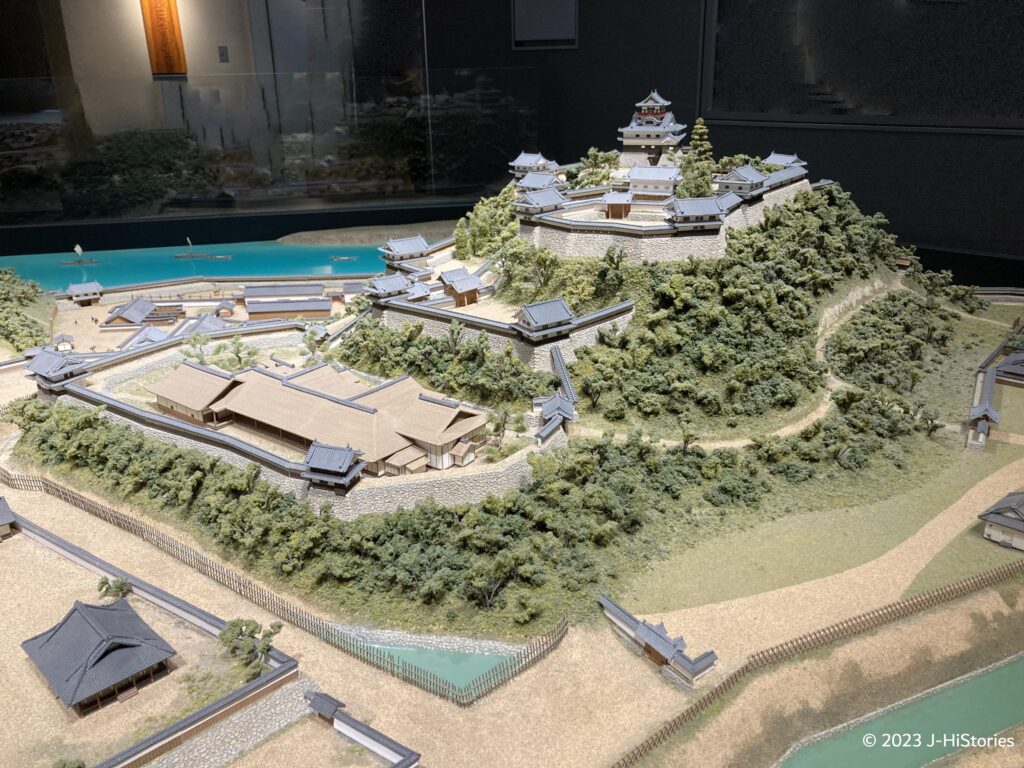
Inuyama Castle sat atop a small hill overlooking the Kiso River, an important transportation hub in the fertile granary of the Nobi Plain. Parallel to the Kiso River, the Nagara and Ibi Rivers, flow towards Ise Bay, making it a key location for wealth, trade, and transportation of troops and supplies.
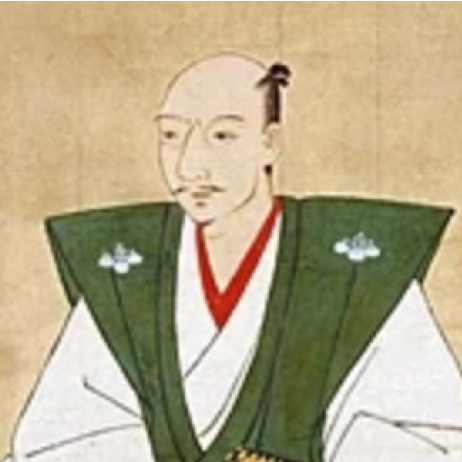
The castle was built in 1537 during the Warring States Period (1467-1590) by Oda Nobuyasu, an uncle of Oda Nobunaga (1534-1582, 織田信長), one of the most powerful warlords. After unifying the Owari region, Nobunaga expanded his territory to the northern Mino Province. Then, Nobunaga’s vassal, Ikeda Tsuneoki, became the castle lord. Shortly before the unification of the nation, Nobunaga fell in 1582 to the rebellion of his vassal Akechi Mitsuhide.
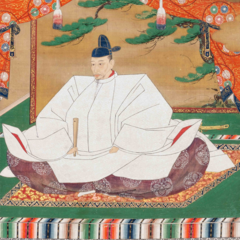
In 1584, the "Battle of Komaki-Nagakute" erupted between Toyotomi Hideyoshi (1537-1598, 豊臣秀吉), a vassal of Nobunaga, and Tokugawa Ieyasu (1543-1616, 徳川家康), an ally of Nobunaga, as they fought over the succession of Nobunaga. Hideyoshi was the first to capture the strategic point, Inuyama Castle. The two sides were deadlocked for about eight months, with Hideyoshi’s headquarters at Inuyama Castle, and Ieyasu’s one at Komakiyama Castle. Eventually, a peace agreement was reached. Then, Inuyama Castle was returned to Nobunaga's second son, Oda Nobukatsu.

In 1600, after the death of Hideyoshi, the "Battle of Sekigahara" erupted by dividing the warlords in Japan between Ieyasu and Ishida Mitsunari. Mitsunari was a royal vassal of Hideyoshi and was pushing for Hideyoshi's heir as the successor. After only around two hours, the battle ended with Ieyasu's victory. Before the battle, both camps engaged in a fierce information war, including espionage and turncoat operations. Inuyama Castle, Mitsunari's frontline base, was also a target of Ieyasu's plotting. Ieyasu forced the surrounding castle lords to surrender one by one, tracking down Inuyama Castle. The castle fell into Ieyasu's hands, becoming a bridgehead for the war.
Outstanding activities of Masanari, the first lord of Inuyama Castle
The Prohibition of making any sounds
In January 1625, the third shogun Tokugawa Iemitsu issued a three-day ban on making any sounds to offer heartfelt prayers for Naruse Masanari's death at the age of 59. Masanari had served Tokugawa Ieyasu since his days as a page, distinguished himself on several battlefields, and served as Ieyasu's close aide. He was buried at Hojoji Temple and later laid to rest at Nikko Toshogu Shrine, where Ieyasu's spirit was enshrined. In addition, Tokugawa Yoshinao (1601-1650, 徳川義直), the first lord of the Owari Tokugawa domain, lamented the news of Masanari's death and built Hakurinji Temple to pray for him.
First Battle and Became General of the Negoro Group troops

Masanari's first battle was the "Battle of Komaki-Nagakute" at the age of 17. Ieyasu fought with only 30,000 men against Hideyoshi’s 100,000 troops. The battle's fiercest moment came when Hideyoshi's forces attempted to assault Ieyasu's stronghold of Mikawa. Sensing this movement, Tokugawa forces quickly repulsed Hideyoshi's army. Despite it being his first battle, Masanari performed a great deed by defeating enemies and severing their heads. The following year, in 1585, Ieyasu entrusted him with 50 Negoro warriors, and he became the general of the Negoro-gumi troops. The Negoro warriors were autonomous and independent forces of Negoroji Temple and were the best gunfighters in the Warring States period in terms of both quantity and quality. However, they were suppressed by Hideyoshi, who feared their strong power. Later, Masanari led 100 Negoro warriors in the Battle of Sekigahara and contributed to Ieyasu's victory.
Ieyasu was his only lord
Under Ieyasu, who established the Tokugawa shogunate in Edo (Tokyo) in 1603, Masanari served as a chief retainer at the center of the shogunate affairs. 1607, he followed Ieyasu to Sunpu Castle. Soon later, Masanari was appointed as the chief retainer of Ieyasu's ninth son, Yoshinao, serving the Owari Tokugawa domain. In 1617, Masanari became the Inuyama castle lord and contributed to the Owari Tokugawa domain’s development and Tokugawa shogunate. When his death was approaching, Masanari repeatedly mentioned that he wanted to go to Nikko, the place where Ieyasu was laid to rest. Understanding Masanari’s loyalty to Ieyasu, the vassals carried a basket around the castle, pretending to be heading to Nikko. Upon hearing the voice of his arrival at Nikko, Masanari passed away in his sleep.
Politics of the Owari Tokugawa Domain were very politics of the Tokugawa Shogunate
The rush of castle buildings

From the time of the Battle of Sekigahara to the early Edo period, around 1600-1620, feudal lords were granted new territories and pushed forward with the construction of castles. Ieyasu also built a series of castles surrounding Osaka Castle in preparation for the next possible battles against the Toyotomi clan. As a result, high-quality timber cut in Kiso, the territory of the Owari domain, and in Hida, under the direct control of the shogunate, was transported through the Kiso River to the rest of the country via Ise Bay. The Owari Tokugawa clan, in which Masanari was in charge of political affairs, played a central role.
Development and Management of the Mino Route, a Major Artery of Transportation
The Owari domain ruled water transportation along the three Kiso rivers (Kiso, Nagara, and Ibi) and the two major roads (Tokaido and Nakasendo), which connected Edo and Kyoto. However, the weakness of the Tokaido Road was the necessity of crossing Ise Bay by boat at a location called "Shichiri-no-Watashi". This made the route unsuitable for travel by horse due to the inability to transport horses on boats. Therefore, the Mino Road was an important alternative route. Mino Road was used in the Battle of Okehazama by Nobunaga, the conquest of Odawara by Hideyoshi, and the Battle of Sekigahara by Ieyasu. While managing this critical Mino Road and supporting logistics, the Owari Domain played a wide range of roles, including guarding against suspicious persons.
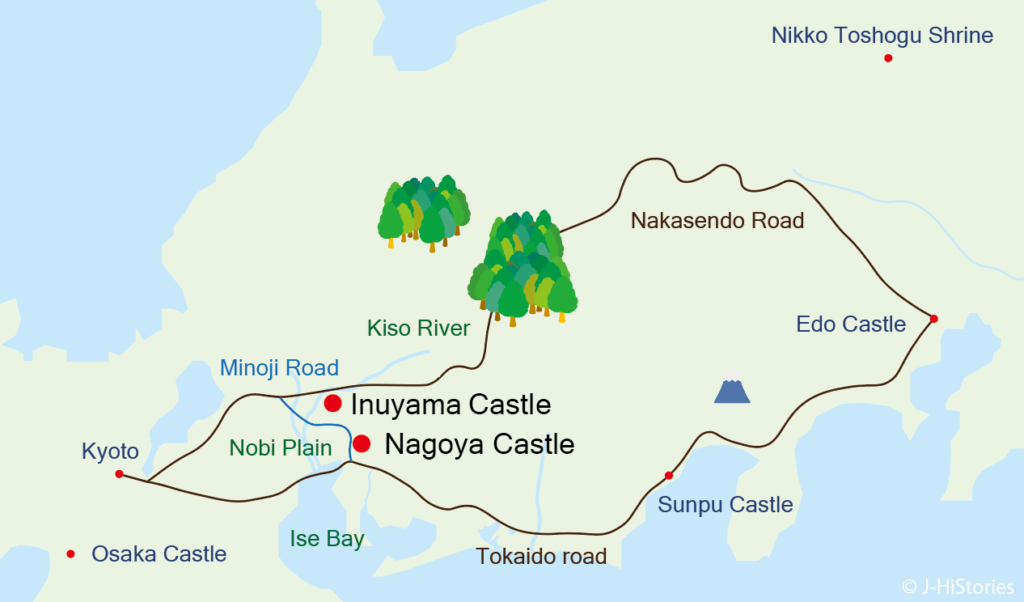
The importance of the Naruse family for the Tokugawa Shogunate
Owari Tokugawa Domain played the key role of the Tokugawa Shogunate, such as lumber supply area, lumber distribution center, the logistics network for good, and administrator of the strategically important three roads of Tokaido, Nakasendo, and Mino. For this, the Naruse clan was responsible for the administration of these affairs as chief retainers of the Tokugawa Owari Domain and the lords of Inuyama Castle from generation to generation until the end of the Edo period. Please visit Inuyama Castle and explore the Naruse family's contributions to the Tokugawa Owari Domain and the Shogunate.
Naruse Masanari Timeline
| 1560 | Nobunaga defeated Imagawa Yoshimoto at the battle of Okehazama | Azuchi Momoyama Period | |
| 1567 | Nobunaga moved to Gifu Casle and started to use the "Tenka-fubu" stamp | ||
| 1567 | Naruse Masanari was born | Age=1 | |
| 1573 | Muromachi Shogunate ended by the 15th Shogun, Yoshiaki was ousted by Nobunaga | 6 | |
| 1582 | Nobunaga was killed at Honnoji by Akechi Mitsuhide | 15 | |
| 1584 | Masanari fought at Komaki-Nagakute battle and took enemy's head | 17 | |
| 1585 | Masanari became the general of Negoro-gumi | 17 | |
| 1586 | Hideyoshi built the huge Osaka castle | 18 | |
| 1590 | Masanari fought at Odawara War | 22 | |
| 1590 | Ieyasu moved to Edo according to Hideyoshi's order | 22 | |
| 1600 | Masanari fought at the Battle of Sakigahara with Negoro-gumi | 32 | |
| 1603 | Ieyasu estabished Tokugawa Shogunate at Edo | 35 | Edo Period |
| 1610 | Masanari beceme the cheif retainer of Tokugawa Yoshinao | 42 | |
| 1615 | Toyotomi's Osaka Castle burnt down to the ground at the Summer Siege of Osaka | 47 | |
| 1616 | Ieyasu passed away at the age of 75 | 48 |
|
| 1617 | Masanari became the lord of Inuyama Castle | 49 | |
| 1625 | Masanari passed away | 57 |
Recommendations to visit
- 30 min from Meitetsu Nagoya Station to Inuyama station (West Exit) on Meitetsu Inuyama Line. A 15-minute walk through the castle town.

